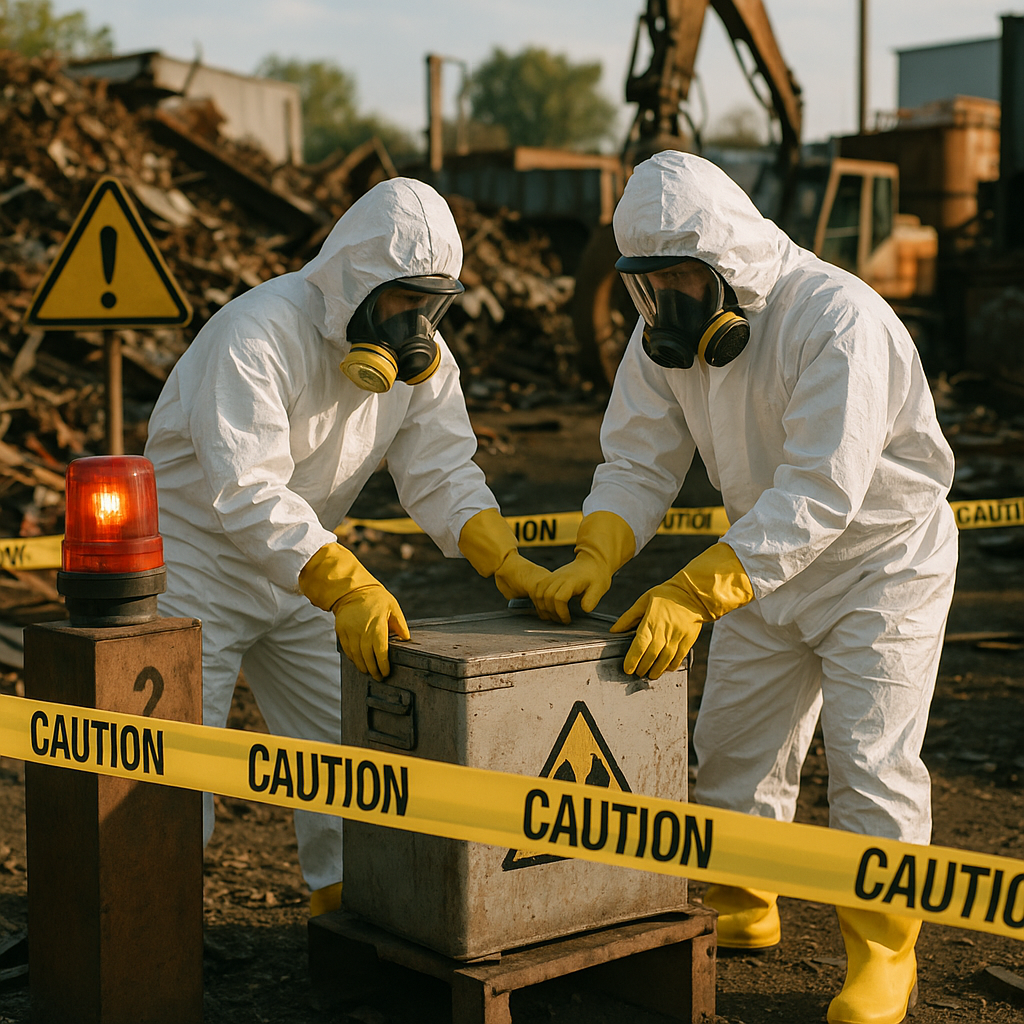5901 Botham Jean Blvd, Dallas, TX 75215
Radioactive Scrap Detection: A Complete Guide to Equipment, Challenges & Safety Protocols
October 18, 2025Detecting radioactive scrap is a vital safety measure in the metal recycling industry. This process monitors scrap metal shipments to identify any materials contaminated with radioactive substances before they enter the recycling stream, serving as the first line of defense against potential radiation exposure.
The metal recycling industry processes millions of tons of scrap each year. Without proper detection systems, radioactive materials could contaminate recycled products, exposing workers and consumers to harmful radiation. Such contamination can have a severe financial impact, often leading to facility shutdowns and the need for extensive decontamination.
Detection usually starts at facility entry points, where vehicles carrying scrap loads pass through specialized radiation portal monitors. These systems use sensitive sensors to detect even small amounts of gamma radiation emitted by radioactive materials, measuring against normal background radiation and triggering alarms when anomalies are found.
What Types of Radiation Detection Equipment are Used?

Scrap yards employ several specialized radiation detection technologies to prevent radioactive materials from entering the recycling stream. These systems range from large-scale facility monitors to portable handheld units, each serving specific functions in the radiation screening process.
Portal Monitoring Systems
Portal monitors are fixed detection systems installed at entry points of scrap facilities. These large structures scan entire vehicles as they pass through, providing the first line of defense against radioactive materials.
The most common portal systems include the ASM IV Series and RC4000 series monitors, which use sensitive scintillation detectors to identify gamma radiation from incoming loads. These systems can detect very low levels of radiation even in high-density materials like compressed scrap metal.
Portal monitors offer several advantages:
- Complete scanning of entire vehicles without manual inspection
- Automated operation with real-time alarm thresholds
- Data logging capabilities for record-keeping and compliance
- Multiple detector panels to ensure comprehensive coverage
Handheld Detection Devices
Once a radioactive source is detected by portal monitors, workers use handheld devices to pinpoint its exact location within a load. The most common types include:
GM (Geiger-Müller) detectors use gas-filled tubes to detect radiation particles. They are ideal for basic radiation surveys and dose rate measurements. Some models feature telescopic wands to reach difficult areas within scrap piles.
Scintillation detectors are more sensitive instruments that use crystal materials (like sodium iodide or PVT) to convert radiation into light pulses. The RadEye series detectors are popular in scrap yards for their ability to detect both gamma and neutron radiation with high sensitivity.
Advanced Spectroscopic Systems
For precise identification of radioactive sources, scrap yards use spectroscopic systems that can determine the specific radionuclides present. These advanced devices analyze the energy spectrum of detected radiation.
RIID (Radioisotope Identification Devices) like the SYCLONE and MSpec analyzers can distinguish between naturally occurring radioactive materials (NORM) and man-made sources. This capability is crucial when determining whether a radioactive alarm requires regulatory reporting.
Some facilities also use laboratory-based systems like the RadSampler, which allows for detailed analysis of small samples in a lead-shielded chamber for maximum accuracy.
Specialized Detection Equipment
The Cricket system represents a specialized approach to radiation detection in scrap yards. This unique device mounts directly on grapples or magnets used to move scrap, bringing detection capabilities directly to the material handling process. This method can identify small, shielded sources that might be missed by other detection methods.
For facilities processing molten metal, conveyor and off-gas monitoring systems provide critical information about accidental smelting of radioactive materials. These systems detect gamma emissions from dust collection systems, offering an additional layer of protection.
What are the Challenges in Radioactive Scrap Detection?
Detecting radioactive materials in scrap poses significant operational challenges for recycling facilities. Well-shielded radioactive sources are particularly difficult to detect. When these materials are deliberately concealed or accidentally buried deep within scrap metal, the surrounding materials can significantly reduce radiation emissions reaching detection equipment. This is especially problematic with large, densely packed shipments where even powerful detection systems might fail to identify deeply embedded sources.
The physical properties of radiation create inherent detection limitations. Alpha particles, despite being highly damaging to human tissue, are easily blocked by even a sheet of paper or the outer layer of skin, making them nearly impossible to detect from outside a container. Beta particles travel slightly farther but are still readily stopped by aluminum or wood. Even gamma radiation, which can penetrate several centimeters of lead, becomes progressively attenuated when passing through dense scrap loads, potentially reducing emissions below detectable thresholds.
Another major challenge stems from the variety of potential radioactive sources that might enter the scrap stream. Industrial radiography equipment containing iridium-192, medical devices with cobalt-60, obsolete lightning rods containing americium-241, and discarded smoke detectors are a few examples. Each radioisotope emits different energy signatures, requiring detection systems versatile enough to identify multiple radiation types and energy levels. This diversity means that no single detection method can reliably identify all possible radioactive contaminants.
Perhaps most frustrating for facility operators are false alarms, which occur frequently. Naturally occurring radioactive materials (NORM) like granite, ceramic tiles, and certain fertilizers contain harmless levels of radioactive elements that can trigger detection equipment. Medical patients who have recently undergone nuclear medicine procedures can set off alarms when their waste or personal items enter the recycling stream. These false positives create operational bottlenecks as each alarm must be thoroughly investigated, diverting resources and slowing processing times.
The balance between sensitivity and practicality presents an ongoing dilemma. Setting detection thresholds too high risks missing dangerous materials, while setting them too low results in numerous false alarms that can lead to “alarm fatigue” among operators. This may eventually cause them to doubt equipment reliability or take shortcuts in verification procedures. Complicating matters further, background radiation levels fluctuate naturally due to weather conditions, with phenomena like temperature inversions potentially causing temporary increases that trigger false alarms.
Successfully addressing these challenges requires a comprehensive approach combining sophisticated detection technology, proper operational procedures, and well-trained personnel who understand both the importance of their role and the limitations of the systems they operate.
What Happens When Radioactive Material is Detected?
The detection of radioactive material triggers the immediate implementation of strict safety protocols. The first priority is to secure the affected area and prevent unauthorized access. This containment measure helps minimize potential exposure to workers and the environment.
Once the area is secured, the radiation protection advisor must be notified without delay. This specialist provides crucial guidance on handling procedures and conducting a risk assessment. Their expertise ensures all actions comply with radiation safety regulations.
Notification and Authority Involvement
Regulatory compliance requires prompt notification of the proper authorities. Environmental agencies, public health departments, and nuclear safety commissions may need to be informed, depending on the type and level of radiation detected.
These authorities help coordinate response efforts and ensure all actions follow legal requirements. They may deploy specialized teams to assist with assessment and containment if the situation exceeds local capabilities.
Documentation begins immediately, recording detection readings, location details, and initial response measures. This information is essential for both immediate handling and future investigation into the contamination source.
Material Isolation and Characterization
The radioactive material must be safely isolated from normal waste streams. Specially designed containment vessels or shielded areas prevent radiation spread while further assessment takes place.
Characterization involves identifying the specific radioactive isotopes present and their concentration levels. This process requires specialized detection equipment operated by trained personnel in appropriate protective gear.
The type of isotope detected significantly impacts subsequent handling protocols. Some materials emit primarily alpha radiation with limited penetration ability, while others produce more dangerous gamma radiation, requiring substantial shielding.
Disposal Procedures
Standard recycling or waste disposal methods cannot be used for radioactive materials. These contaminated items require specialized handling through designated radioactive waste channels.
Disposal options depend on the half-life and radiation level of the detected material. Short-lived, low-level radioactive waste may be stored until activity levels naturally decrease to safe limits.
More hazardous materials require transportation to licensed disposal facilities with long-term containment capabilities. This process involves specialized transport containers and vehicles operated by certified handlers.
Impact on Processing Operations
When radioactive contamination is found in recycling loads, normal processing must halt for the affected materials. The contaminated portion is segregated while the facility determines if other materials have been cross-contaminated.
Operations may resume for unaffected areas after thorough testing confirms no radiation spread. However, equipment that contacted the radioactive material requires decontamination and verification before returning to service.
The financial and operational impacts can be significant. Extended shutdowns, specialized cleanup, and disposal costs all affect facility operations. Prevention through proper screening remains the most effective approach to avoiding these disruptions.
Ensuring Safety with Effective Radioactive Scrap Detection

Effective radioactive scrap detection is a crucial safeguard for the recycling industry. Monitoring systems that identify radiation in scrap metal are the first line of defense against potentially devastating consequences. Without these systems, workers face direct exposure to harmful ionizing radiation, which can cause immediate health problems and long-term risks such as increased cancer rates.
Beyond worker safety, these detection systems protect the environment and the public from contamination spread through processed metals. The financial implications cannot be overlooked—a single contamination event can incur millions in costs for cleanup, facility decontamination, and production downtime. If radioactive material is melted with regular scrap, entire facilities can become contaminated, necessitating extensive and costly remediation.
For your metal recycling needs and to ensure proper radiation detection protocols, contact Okon Recycling at 214-717-4083.
